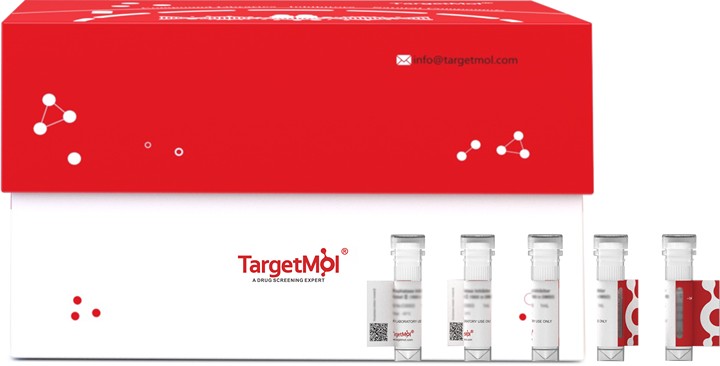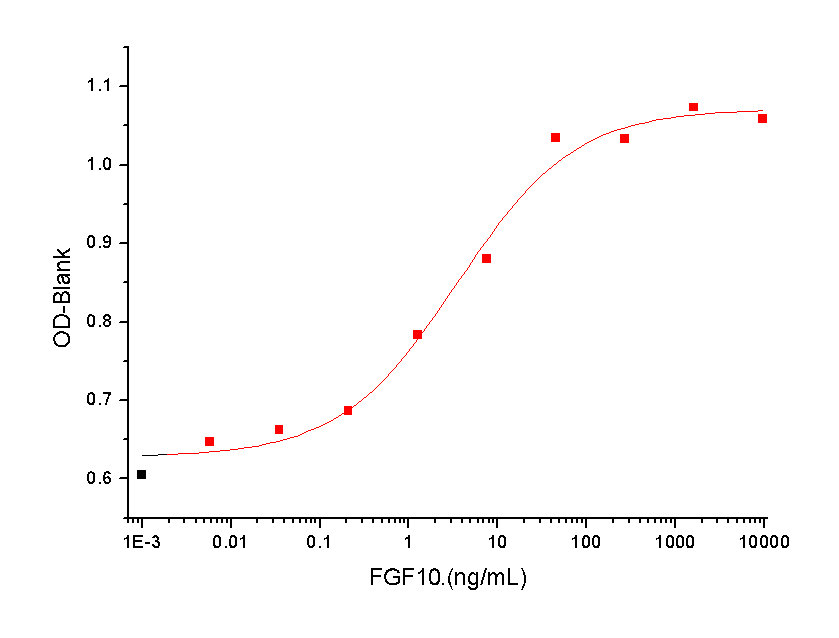 您的购物车当前为空
您的购物车当前为空
FGF-10 Protein, Human, Recombinant
一键复制产品信息别名 KGF2, fibroblast growth factor 10
Fibroblast growth factor 10 (FGF10) is a member of the fibroblast growth factor (FGF) family. FGF family members possess broad mitogenic and cell survival activities, and are involved in a variety of biological processes, including embryonic development, cell growth, morphogenesis, tissue repair, tumor growth and invasion. FGF10 exhibits mitogenic activity for keratinizing epidermal cells, but essentially no activity for fibroblasts, which is similar to the biological activity of FGF7. FGF10 plays an important role in the regulation of embryonic development, cell proliferation and cell differentiation. FGF10 is required for normal branching morphogenesis. It may play a role in wound healing. Defects in FGF10 are the cause of autosomal dominant aplasia of lacrimal and salivary glands (ALSG). ALSG has variable expressivity, and affected individuals may have aplasia or hypoplasia of the lacrimal, parotid, submandibular and sublingual glands and absence of the lacrimal puncta. The disorder is characterized by irritable eyes, recurrent eye infections, epiphora (constant tearing) and xerostomia (dryness of the mouth), which increases the risk of dental erosion, dental caries, periodontal disease and oral infections.

FGF-10 Protein, Human, Recombinant
一键复制产品信息Fibroblast growth factor 10 (FGF10) is a member of the fibroblast growth factor (FGF) family. FGF family members possess broad mitogenic and cell survival activities, and are involved in a variety of biological processes, including embryonic development, cell growth, morphogenesis, tissue repair, tumor growth and invasion. FGF10 exhibits mitogenic activity for keratinizing epidermal cells, but essentially no activity for fibroblasts, which is similar to the biological activity of FGF7. FGF10 plays an important role in the regulation of embryonic development, cell proliferation and cell differentiation. FGF10 is required for normal branching morphogenesis. It may play a role in wound healing. Defects in FGF10 are the cause of autosomal dominant aplasia of lacrimal and salivary glands (ALSG). ALSG has variable expressivity, and affected individuals may have aplasia or hypoplasia of the lacrimal, parotid, submandibular and sublingual glands and absence of the lacrimal puncta. The disorder is characterized by irritable eyes, recurrent eye infections, epiphora (constant tearing) and xerostomia (dryness of the mouth), which increases the risk of dental erosion, dental caries, periodontal disease and oral infections.
| 规格 | 价格 | 库存 | 数量 |
|---|---|---|---|
| 5 μg | ¥ 591 | 现货 | |
| 10 μg | ¥ 989 | 现货 | |
| 20 μg | ¥ 1,650 | 现货 | |
| 50 μg | ¥ 3,230 | 3日内发货 | |
| 100 μg | ¥ 5,410 | 现货 |
产品介绍
| 产品描述 | Fibroblast growth factor 10 (FGF10) is a member of the fibroblast growth factor (FGF) family. FGF family members possess broad mitogenic and cell survival activities, and are involved in a variety of biological processes, including embryonic development, cell growth, morphogenesis, tissue repair, tumor growth and invasion. FGF10 exhibits mitogenic activity for keratinizing epidermal cells, but essentially no activity for fibroblasts, which is similar to the biological activity of FGF7. FGF10 plays an important role in the regulation of embryonic development, cell proliferation and cell differentiation. FGF10 is required for normal branching morphogenesis. It may play a role in wound healing. Defects in FGF10 are the cause of autosomal dominant aplasia of lacrimal and salivary glands (ALSG). ALSG has variable expressivity, and affected individuals may have aplasia or hypoplasia of the lacrimal, parotid, submandibular and sublingual glands and absence of the lacrimal puncta. The disorder is characterized by irritable eyes, recurrent eye infections, epiphora (constant tearing) and xerostomia (dryness of the mouth), which increases the risk of dental erosion, dental caries, periodontal disease and oral infections. |
| 生物活性 | 1. Measured in a cell proliferation assay using BaF3 mouse pro-B cells transfected with human FGFR2b. The ED50 for this effect is typically 3-30 ng/mL. 2. Human lung cancer organoids were cultured with FGF2 (Cat#TMPY-00749), FGF4 (Cat#TMPY-05004), FGF7 (Cat#TMPY-00403), EGF (Cat#TMPY-03701), FGF10 (Cat#TMPY-01061), NOG (Cat#TMPY-02594), RSPO1 (Cat#TMPY-03626). 3. Human lung organoids were cultured with FGF2 (Cat#TMPY-00749), FGF4 (Cat#TMPY-05004), FGF7 (Cat#TMPY-00403), EGF (Cat#TMPY-03701), FGF10 (Cat#TMPY-01061), NOG (Cat#TMPY-02594), RSPO1 (Cat#TMPY-03626). 4. Human cholangiocarcinomas organoids were cultured with FGF2 (Cat#TMPY-00749), HGF (Cat#TMPY-02327), FGF7 (Cat#TMPY-00403), EGF (Cat#TMPY-03701), FGF10 (Cat#TMPY-01061), NOG (Cat#TMPY-02594), RSPO1 (Cat#TMPY-03626). 5. Human liver cancer organoids were cultured with FGF2 (Cat#TMPY-00749), HGF (Cat#TMPY-02327), FGF7 (Cat#TMPY-00403), EGF (Cat#TMPY-03701), FGF10 (Cat#TMPY-01061), TGFB1 (Cat#TMPY-02638), NOG (Cat#TMPY-02594), RSPO1 (Cat#TMPY-03626). 6. Human kidney cancer organoids were cultured with FGF2 (Cat#TMPY-00749), FGF7 (Cat#TMPY-00403), EGF (Cat#TMPY-03701), FGF10 (Cat#TMPY-01061), NOG (Cat#TMPY-02594), RSPO1 (Cat#TMPY-03626). 7. Human kidney organoids were cultured with FGF7 (Cat#TMPY-00403), EGF (Cat#TMPY-03701), FGF10 (Cat#TMPY-01061), NOG (Cat#TMPY-02594), RSPO1 (Cat#TMPY-03626), HGF (Cat#TMPY-02327), FGF4 (Cat#TMPY-05004). 8. Human gastric cancer organoids were cultured with EGF (Cat#TMPY-03701), FGF10 (Cat#TMPY-01061), NOG (Cat#TMPY-02594), RSPO1 (Cat#TMPY-03626). 9. Human stomach organoids organoids were cultured with EGF (Cat#TMPY-03701), FGF10 (Cat#TMPY-01061), NOG (Cat#TMPY-02594), RSPO1 (Cat#TMPY-03626). 10. Human small intestinal organoids were cultured with IL22 (Cat#TMPY-03490), FGF10 (Cat#TMPY-01061), EGF (Cat#TMPY-03701), NOG (Cat#TMPY-02594).  |
| 研究背景 | Fibroblast growth factor 10 (FGF10) is a member of the fibroblast growth factor (FGF) family. FGF family members possess broad mitogenic and cell survival activities, and are involved in a variety of biological processes, including embryonic development, cell growth, morphogenesis, tissue repair, tumor growth and invasion. FGF10 exhibits mitogenic activity for keratinizing epidermal cells, but essentially no activity for fibroblasts, which is similar to the biological activity of FGF7. FGF10 plays an important role in the regulation of embryonic development, cell proliferation and cell differentiation. FGF10 is required for normal branching morphogenesis. It may play a role in wound healing. Defects in FGF10 are the cause of autosomal dominant aplasia of lacrimal and salivary glands (ALSG). ALSG has variable expressivity, and affected individuals may have aplasia or hypoplasia of the lacrimal, parotid, submandibular and sublingual glands and absence of the lacrimal puncta. The disorder is characterized by irritable eyes, recurrent eye infections, epiphora (constant tearing) and xerostomia (dryness of the mouth), which increases the risk of dental erosion, dental caries, periodontal disease and oral infections. |
| 种属 | Human |
| 表达系统 | E. coli |
| 标签 | Tag Free |
| 蛋白编号 | O15520 |
| 蛋白构建 | A DNA sequence encoding the mature form of human FGF10 (NP_004456.1) (Gln38-Ser208) was expressed. Predicted N terminal: Met |
| 蛋白纯度 | ≥ 95 % as determined by SDS-PAGE. ≥ 95 % as determined by SEC-HPLC.   |
| 蛋白性状 | Lyophilized powder |
| 缓冲液 | Lyophilized from a solution filtered through a 0.22 μm filter, containing PBS, pH 7.4. Typically, a mixture containing 5% to 8% trehalose, mannitol, and 0.01% Tween 80 is incorporated as a protective agent before lyophilization. |
| 复溶方法 | A Certificate of Analysis (CoA) containing reconstitution instructions is included with the products. Please refer to the CoA for detailed information. |
| 别名 | KGF2, fibroblast growth factor 10 |
| 内毒素 | < 5 EU/mg of the protein. |
| 分子量 | 19.46 kDa (predicted); 19.46 kDa (reducing conditions) |
| 颜色 | White |
| 物理性状 | Lyophilized powder |
| 运输方式 | In general, Lyophilized powders are shipping with blue ice. |
| 存储 | It is recommended to store recombinant proteins at -20°C to -80°C for future use. Lyophilized powders can be stably stored for over 12 months, while liquid products can be stored for 6-12 months at -80°C. For reconstituted protein solutions, the solution can be stored at -20°C to -80°C for at least 3 months. Please avoid multiple freeze-thaw cycles and store products in aliquots. |
计算器
剂量转换
对于不同动物的给药剂量换算,您也可以参考 更多




 很棒
很棒
 |
|